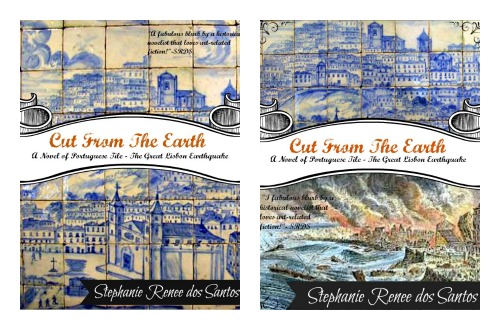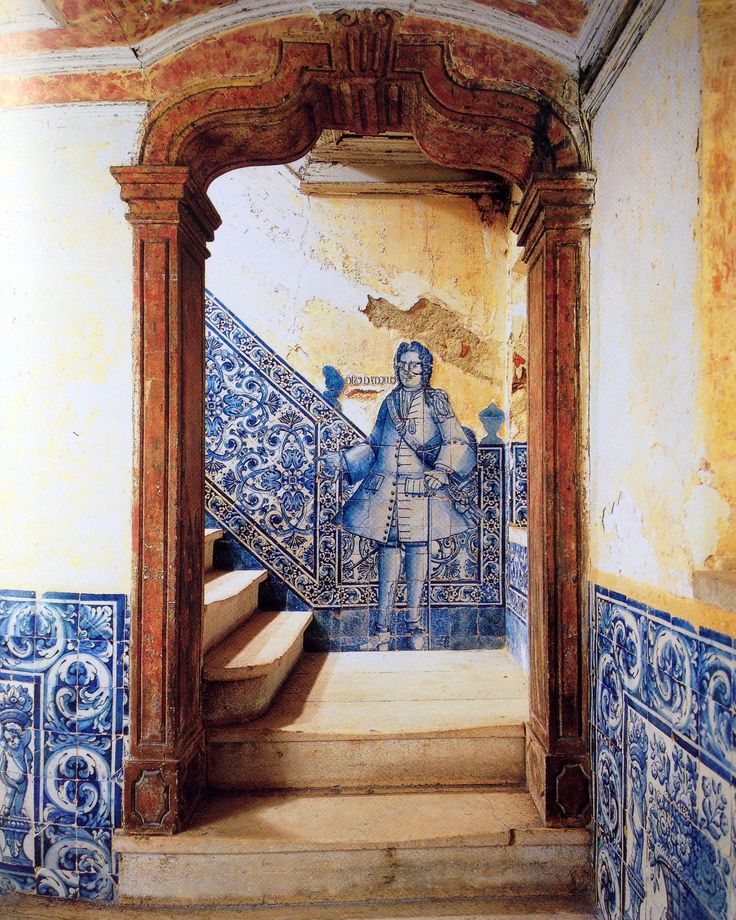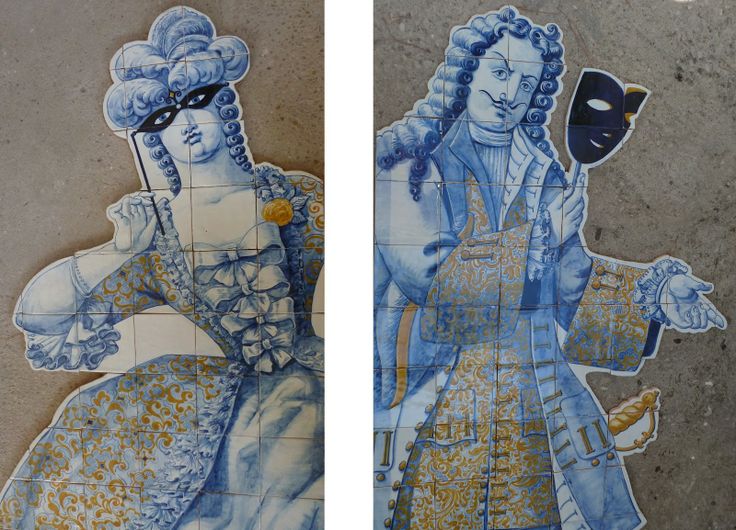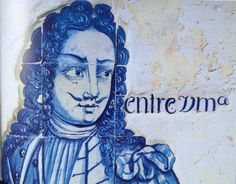Firstly, what is a “figura de convite“?
A figura de convite is an invitation figure made of *azulejos, tiles. They’re life-sized tile cut-out images of a finely dressed nobleman or lady, halberdiers or a footman that were affixed to walls at the entrances of palaces, on stair-landings, and patios to welcome visitors during the eighteenth century in Portugal and Brazil.
* “Azulejo” is the Portuguese term for a glazed tile. The word comes from Arabic الزليج “al zulaycha” meaning little polished stone, and is not to be confused with “azul”, blue, which it is often mistaken. It is true that there are many blue azulejos, and that can explain the confusion, but, historically, the first glazed tiles that appeared on the Iberian peninsula, brought by the Muslim Moors in the thirteenth century, were glazed in mainly hunters green, burnt sienna, and mustard yellow.
 The figura de convite appeared in Portugal around the year of 1720. The innovation was the first time in the history of tile fabrication that the medium deviated from the square composition and embraced the outline of the cut-out, thus opening up a new world of tile designs. Its creation is attributed to the master tile maker who went by the monogram PMP, and whose life story has been lost to history.There’s speculation that possibly the artist’s initials were those of Padre Manuel Pereira, a clergyman and patron to a large tile making workshop (shop name unknown) in Lisbon. His disciples are thought to have produced tiles for palaces and churches all over Portugal and Brazil. But there is no exacting evidence and secure proof that he really is or was the famous monogram PMP…it’s a mystery of art history.
The figura de convite appeared in Portugal around the year of 1720. The innovation was the first time in the history of tile fabrication that the medium deviated from the square composition and embraced the outline of the cut-out, thus opening up a new world of tile designs. Its creation is attributed to the master tile maker who went by the monogram PMP, and whose life story has been lost to history.There’s speculation that possibly the artist’s initials were those of Padre Manuel Pereira, a clergyman and patron to a large tile making workshop (shop name unknown) in Lisbon. His disciples are thought to have produced tiles for palaces and churches all over Portugal and Brazil. But there is no exacting evidence and secure proof that he really is or was the famous monogram PMP…it’s a mystery of art history.
During the first part of the eighteenth century and up until “The Great Lisbon Earthquake of 1755″, Portugal was at the pinnacle of its wealth and extravagance, arguably the richest European country during this time period, and all due to the gold and precious gem extraction from its colony, Brazil, and the slave trade from Africa.
Around the year of 1730, yellow detail work began appearing in the figures, mimicking the use of gold thread being used in cloth embroidery work, demonstrating the vast amounts of gold coming into Portugal from Brazil. It was also around this time that the powdered wig hairstyles of the figures began to visibly shift to a less showy display, recording the period’s shifting tastes.
Innovations of the figura de convite was ongoing with figures like this Roman centurion (left) and rare musical duo with a wiry dog (right).
Words of greeting were sometimes incorporated into the compositions, like this fellow whose beckoning: “Come in your Lordship”. The art form of tile making flourished in Portugal during the eighteenth century with the country’s peerless affluence, and produced one of the greatest world-wide advancements in tile making: the figura de convite.

Two “mock” book jacket ideas for CUT FROM THE EARTH (despite the fact I hope to be traditionally published and have the publisher’s art department work out a fantastic book jacket!)
The figura de convite is one of the artwork highlights in my forthcoming art-based historical novel Cut From the Earth, a story of Portuguese tile and its surprising makers — The Great Lisbon Earthquake of 1755 — and the wisdom of nature to guide heal.





Fascinating story! Thanks for sharing!!
Thanks for taking a moment to read this post!Best~ Stephanie
Wow how interesting. There is a homage to Portugese tile making in an amazing public gardens in Funchal, the capital of Madeira Well worth a visit.
Jon- Thank you for letting me know about this, it is now on my list of places to visit when in Funchal on the island of Madeira.
I’ve always loved the tiles of Portugal, but I didn’t know about the “figura de convite.” Thanks for the history lesson! ~ Sara Hayden
Sara- I’ve loved Portuguese tiles since I lived in the Algrave one summer when I was 19 years old. But I too didn’t know about the “figura de convite” until I started researching intensely for my novel and then I uncovered incredible and important art history details like these invitation figures…and everything just keep flowing out from there…connecting the historical “dots”!
I wasn’t sure if you had chosen a cover yet, but I, too, prefer the one on the left. The vertical aspect gives my eye a better sense of flow.
Forgot to say in my first post that I have a Pinterest board just for tile. 🙂
Sara- Thanks for the feedback on the mock book jackets. Both are just ideas I had in my head and one day just played around to realize them. I plan on trying to go the traditional route for publishing and more than likely (if I can get picked up) a publisher’s art department will come up with a new book jacket, but I have these two to offer as ideas should the moment arrive! Please share here your Pinterest link to your board just for tile! I’d love to visit it. Cheers!
Here’s my Pinterest board for tiles. It’s not strictly Portuguese; there are some Gaudi’s work in Spain (I think from La Familia Sagrada), some Indian tile, some Mexican tile, and some tiles I just think are cool. Enjoy!
http://www.pinterest.com/sarasinparis/tiles/
Sara- Thanks! I’m off to ogle over your Pinterest page! I love tiles of the world too! Best!
Wow! The photos are great and I love learning the story behind your story. I vote for the book cover on the left!
Fiona- Thanks so much for taking a moment to read this post. It’s amazing that its taken years and years of research to be able to write this succinct historical post! And thanks for letting me know which mock book cover you like! Beijos!
This is so fascinating! No one but the Portuguese did this? That’s just amazing!
Jemille- Thanks for visiting this post! As far as I’ve been able to glean from my years of research over this novel and the topic of the history of Portuguese tile, “yes”, the “figura de convite” advancement is unique to the Portuguese. I’m meeting in person with my Portuguese (who is specialized in the history of Portuguese tile) art historian come September in Lisbon and I will yet again field/double-fact check this art history point. But from all the contact and questions and the all-ready-in-print art history books focusing on Portuguese tile — it is true the “figure de convite” was developed first by the Portuguese around the year of 1720 by tile maker PMP.
So interesting, Stephanie! I love learning about the language and artistic techniques that you’ve researched for this history. And beautiful examples!
Jennifer- It has been fascinating, the whole process of researching and discovering tidbits and facts for this novel. I have to admit I’ve loved every minute of it!
Fascinating. This is an area of art I knew nothing about. I’m certain I will be educated as well as moved by CUT FROM THE EARTH.
And this, Susan is my wish! Thanks so much for stopping by and reading this post, been years in the making.